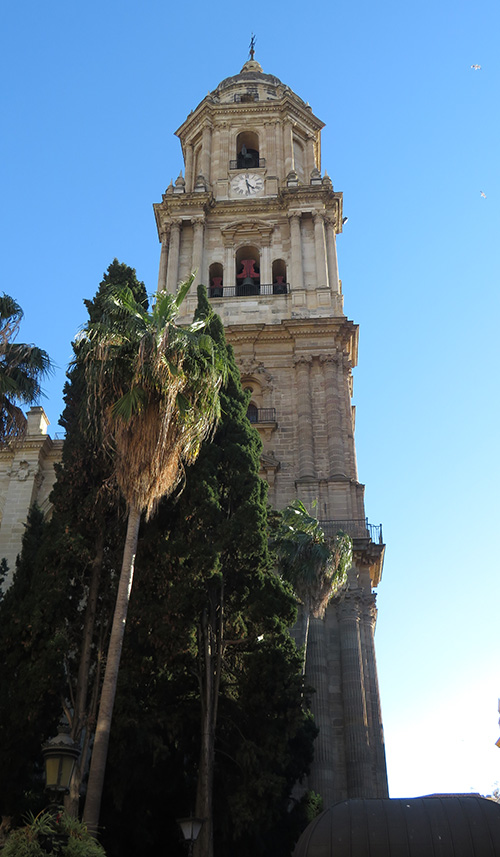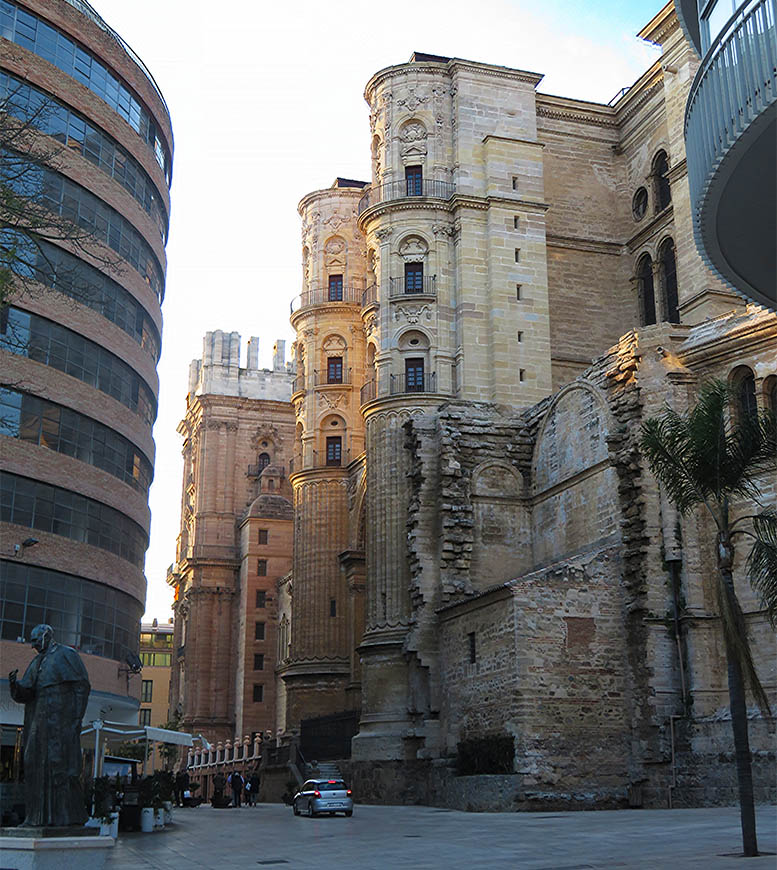La versión español está después de la versión inglés.
During my haphazard wanderings around Málaga yesterday afternoon, I walked by the cathedral a few times. It was built between 1528 and 1782 with a Renaissance style interior and a gothic style exterior. The odd thing about the cathedral, however, is the fact that although it has two towers, only one was ever completed.
According to a plaque at its base, the south tower was unfinished because the money was used to help the American colonies win their independence from Great Britain. It’s a nice story, but doesn’t appear to be true. According to parish records from the time, the money was more likely used to renovate a road and make improvements in a wealthy part of the city. What is true is that, as a result of its appearance, the cathedral’s nickname is “La Manquita” (The One-Armed Lady).
.
Durante mis paseos en Málaga ayer, caminé por la catedral unas cuantas veces. Fue construido entre 1528 y 1782 con un interior de estilo renacentista y un exterior de estilo gótico. Lo extraño de la catedral, sin embargo, es el hecho de que aunque tiene dos torres, solo una fue completada.
Según una placa en su base, la torre sur no estaba terminada porque el dinero se usó para ayudar a las colonias estadounidenses a obtener su independencia de Gran Bretaña. Es una buena historia, pero no parece ser verdad. Según los registros de la parroquia de la época, el dinero era más probable que se usara para renovar una carretera y hacer mejoras en una parte rica de la ciudad. Lo que sí es cierto es que, como resultado de su apariencia, el apodo de la catedral es “La Manquita.”


North Tower / Torre Norte 
South Tower / Torre Sur



Very interesting little tidbit of local historical significance. Wonder what the true reason was.
LOVE the last photo! old facing the new!!
Jim:
Well, I’m guessing the parish records are much closer to the truth. And, yes, I also love that contrast of contemporary and antique!
Odd that they didn’t eventually complete the south tower, but very cool history.
BTW – I tried 3 x yesterday to leave a comment, but it never “took”. Hope this one stays!
Wilma:
Well, we’re back in business I think! There have been many proposals to complete the tower over the years. But it requires government funds (CHURCH!!!)… so doesn’t get much traction. The most recent proposal was just last year.
Interesting. Does that cathedral get a lot of American tourists? Maybe that accounts for the plaque.
Kirk:
Lots of American tourists visit Málaga (although much less here in Fuengirola). And all the cruise ships, too!
Either way, they’re both spectacular. I love beautiful old architecture. What an awesome place to see while you’re eating your yummy nutty dessert. 🙂
hollihd:
There are also some really great cafes with views of the cathedrals. And often excellent musical street performers.
Great building, one tower is enough. Money being diverted from one project to another, nothing to see here in DC.
David:
I hear now our social security is going to pay for the wall… until of course Mexico pays it all back. There have been movements over the years to finish the second tower — as recently as last year. But, so far, they get no traction. (Maybe the plan is to use that money to pay for the wall.)
Wow, that’s stunning!!!!!! I wish I was there to go with you, I’d have loved seeing that.
Mistress Maddie:
Oh what an honor that would be!
Beautiful !
We have Mission San Xavier del Bac, it has an unfinished tower also. We were always told that since the mission was unfinished
Spain could not tax the church. Not sure if that is right.
cheers, parsnip
Parsnip:
There are so many stories about the unfinished tower of Mission San Xavier del Bac. Wouldn’t you love to know the truth.
A charming story!
Debra:
If unlikely…
That fed my architecture need for the day! The old buildings are just so beautiful.
Bob:
You’d be well fed around here.
co-exist of old and new architectural styles.
anne marie:
I love that contrast. There are also a majority of buildings in town built in the early 1900s that have the style of much earlier times.